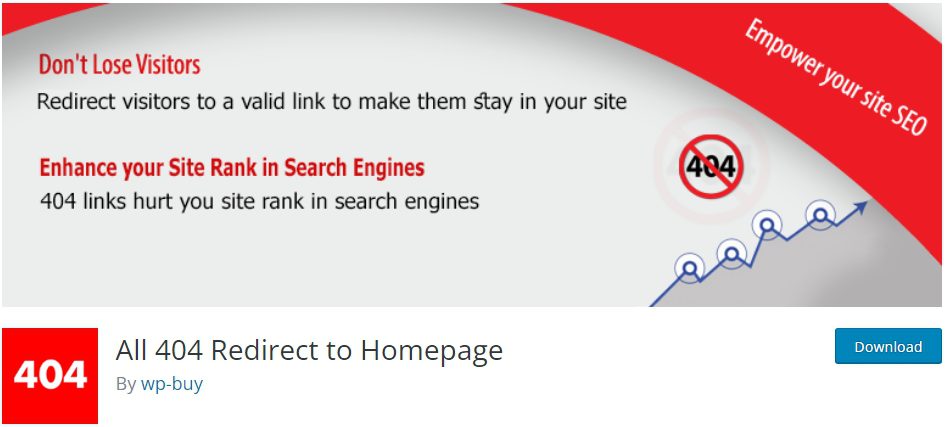Have you ever stumbled upon a 404 error page while browsing the web? If so, you know how frustrating it can be.
Not only does it interrupt your browsing experience, but it also makes it harder for you to find the information you were looking for. As a website owner, you can avoid these issues by redirecting all 404 errors to your homepage.
In this article, we’ll cover everything you need to know about all 404 redirect to homepage, from why it’s important to how to implement it on your website.
Table of Contents
What is “All 404 Redirect to Homepage”
“All 404 Redirect to Homepage” is a WordPress plugin that automatically redirects any pages that return a 404 error to the homepage of your website.
When a visitor clicks on a broken link or attempts to access a page that doesn’t exist on your site, they will be redirected to your homepage instead of seeing the standard 404 error page.
This can help improve user experience by reducing frustration and helping visitors easily navigate your site. The plugin can also help improve SEO by redirecting broken links and preventing them from negatively impacting your search engine rankings.

Why Redirect 404 Errors to the Homepage?
Before we dive into the technical details, let’s first understand why redirecting 404 errors to the homepage is essential for your website.
Avoid Lost Traffic
When a user encounters a 404 error, they’re likely to leave your website and never return. By redirecting all 404 errors to your homepage, you can retain these visitors and prevent lost traffic.
Improve User Experience
A 404 error can be frustrating and confusing for users, especially if they’re new to your website. By redirecting them to your homepage, you can offer a better user experience and make it easier for them to navigate your site.
Boost Search Engine Ranking
When search engines crawl your website and encounter a 404 error, they may lower your search engine ranking. By redirecting all 404 errors to your homepage, you can improve your website’s SEO and boost your search engine ranking.
All 404 Redirect to Homepage: How to Redirect With Plugin
To redirect 404 pages with the “All 404 Redirect to Homepage” plugin on WordPress, you can follow these steps:
- Install and activate the plugin on your WordPress site.
- Go to the plugin’s settings page, which can be found in the WordPress dashboard under Settings > All 404 Redirect to Homepage.
- On the settings page, you can customize the plugin’s options, such as whether to log redirected URLs and whether to display a message to users when a redirect occurs.
- By default, the plugin will redirect all 404 errors to the homepage, but you can also specify a different URL to redirect to if desired.
- Save your changes, and the plugin will automatically redirect any 404 errors to the specified URL.
It’s important to note that while this plugin can be a helpful tool for managing 404 errors, it’s still a good practice to fix broken links and missing pages on your site to ensure the best user experience and SEO results.
Alternative WordPress Plugin
If you’re using a CMS like WordPress, you can use a plugin to redirect 404 errors to your homepage. Here are some popular plugins you can use:

How to Redirect 404 Page in WordPress Without Plugin
Now that you understand why it’s crucial to redirect 404 errors to your homepage let’s dive into the technical details of how to direct 404 page without plugins on your website.
Modify Your .htaccess File
One way to redirect all 404 errors to your homepage is by modifying your .htaccess file. Here’s how to do it:
Open your .htaccess file using a text editor.
Add the following code to the file:
# Redirect all 404 errors to the homepage ErrorDocument 404 http://www.yourwebsite.com/
Save and upload the updated .htaccess file to your website’s root directory.
Modify Your Website’s Code
If you’re comfortable with coding, you can modify your website’s code to redirect all 404 errors to your homepage. Here’s an example of how to do it in PHP:
// Redirect all 404 errors to the homepage
add_action( 'template_redirect', 'redirect_404_to_homepage' );
function redirect_404_to_homepage() {
if ( is_404() ) {
wp_redirect( home_url() );
exit;
}
}
Best Practices for Redirecting 404 Errors to the Homepage
Now that you know how to implement all 404 redirect to homepage, let’s go over some best practices to make sure you’re doing it correctly.
Test Your Redirects
After implementing the redirect, test it thoroughly to ensure that it’s working correctly. You can use a tool like Redirect Checker to test your redirects and make sure they’re working correctly.
Use a 301 Redirect
When redirecting all 404 errors to the homepage, use a 301 redirect instead of a 302 redirect. A 301 redirect is a permanent redirect, while a 302 redirect is a temporary redirect.
Using a 301 redirect will ensure that search engines understand that the redirect is permanent, and it won’t affect your website’s SEO negatively.
Customize Your 404 Page
Even though redirecting all 404 errors to the homepage is a best practice, it’s still important to have a customized 404 page. A customized 404 page can help users find the information they were looking for and offer a better user experience.
Monitor Your Website’s 404 Errors
Monitor your website’s 404 errors regularly to ensure that your redirects are working correctly and to identify any new 404 errors. You can use tools like Google Search Console or SEMrush to monitor your website’s 404 errors.
How Do 404 Errors Affect SEO?
When a user encounters a 404 error while browsing your website, it means that the requested page is not available or cannot be found. If your website has multiple 404 errors, it can negatively affect your website’s SEO.
Search engines crawl your website regularly to update their index of your website’s pages, and if they encounter too many 404 errors, it can impact your website’s ranking.
This is because search engines interpret 404 errors as a signal that your website has low quality or outdated content.
Default 404 Error Page VS Customized 404 Error Page
A default 404 error page is the page that a user sees when they try to access a page on your website that does not exist. This is usually a generic page that is automatically generated by your server.
On the other hand, a customized 404 error page is a page that you design specifically to be shown when a user encounters a 404 error.
A customized 404 error page can help to retain visitors and provide a better user experience by suggesting alternative pages they may be interested in or providing links to relevant content.
What Are the Potential Drawbacks of “404 Redirect to Homepage”?
One of the potential drawbacks of “404 Redirect to Homepage” is that it may not always be the best option for your website. If a user encounters a 404 error while trying to access a specific page, redirecting them to the homepage may not be helpful or relevant to their search.
This approach also eliminates the opportunity to provide users with alternative pages or resources that may be more relevant to their search.
In addition, if the 404 error is caused by a mistyped URL, redirecting to the homepage may not help the user find the content they were looking for.

FAQs
Will Redirecting All 404 Errors to the Homepage Affect My Website’s SEO Negatively?
No, it won’t. In fact, it can improve your SEO by reducing the number of 404 errors on your website and improving user experience.
Can I Redirect 404 Errors to a Different Page Instead of the Homepage?
Yes, you can. However, redirecting to the homepage is the most common practice and it’s recommended for the reasons mentioned above.
Will Redirecting All 404 Errors to the Homepage Affect My Website’s Load Time?
No, it won’t. The redirect happens very quickly, and it won’t have a noticeable impact on your website’s load time.
How Can I Check if My Website Has Any 404 Errors?
You can use tools like Google Search Console or SEMrush to identify any 404 errors on your website.
How Do I Implement 404 page redirect to the homepage of My Website?
To implement 404 page redirect to the homepage on your website, you will need to edit your website’s .htaccess file or use a plugin if you are using a CMS such as WordPress or Drupal.
You will need to add a code snippet that redirects all 404 errors to the homepage URL. It is important to test this approach thoroughly to ensure that it works as intended and does not cause any issues.
Can “404 Redirect to Homepage” Negatively Affect My Website’s Seo?
While “404 Redirect to Homepage” can be an effective way to handle 404 errors, it may not be the best option for every website.
If you have a large number of 404 errors, redirecting all of them to the homepage can result in a high bounce rate, which can negatively impact your website’s SEO.
It is important to carefully consider the potential impact on user experience and SEO before implementing this approach.
Are There Any Alternatives to “Redirect to Homepage” for Handling 404 Errors?
Yes, there are several alternatives to “Redirect to Homepage” for handling 404 errors.
One alternative is to create customized 404 error pages that provide users with helpful information, such as links to related content or a search box to help them find what they are looking for.
Another alternative is to use 301 redirects to redirect users from the old URL to a new URL that contains the same or similar content.
How Do I Test My Website’s 404 Error Handling?
To test your website’s 404 error handling, you can use a web crawling tool to scan your website and identify any broken links or 404 errors. You can also manually test your website by entering a non-existent URL and checking the response.
It is important to test your website’s error handling regularly to ensure that it is working correctly and providing a good user experience for your visitors.
You can also use tools like Google Search Console to identify 404 errors on your website and see which pages are affected.
What Causes 404 Errors?
404 errors can be caused by a number of factors, including mistyped URLs, broken links, deleted pages, and server issues.
How Do I Create a Customized 404 Error Page?
To create a customized 404 error page, you can use HTML, CSS, and JavaScript to design a page that provides users with helpful information and links to relevant content.
Can 404 Errors Impact My Website’s Ranking?
Yes, having a large number of 404 errors can negatively impact your website’s ranking by signaling to search engines that your website has low-quality or outdated content.
Should I Redirect All 404 Errors to the Homepage?
Redirecting all 404 errors to the homepage may not be the best option for every website. It’s important to carefully consider the potential impact on user experience and SEO before implementing this approach.
Conclusion: All 404 Redirect to Homepage
Redirecting all 404 errors to the homepage is a best practice that can improve user experience, reduce lost traffic, and boost your website’s SEO. Implementing it on your website is relatively simple, and there are multiple methods you can use.
However, make sure to follow best practices and monitor your website’s 404 errors to ensure that everything is working correctly.
By doing so, you can offer a better user experience and improve your website’s performance.
Fix 8 Common WordPress Errors
If you’re looking for more tips on how to fix WordPress errors, we’ve got you covered. Check out our following post on common WordPress errors and how to fix them.
- How to Fix Internal Server Error 500.
- How to Fix Syntax Errors in WordPress.
- How to Fix the WordPress White Screen of Death.
- How To Fix The Image Upload Issue In WordPress.
- How to Fix The WordPress Memory Exhausted Error.
- How to Fix the Error Establishing a Database Connection in WordPress.
- How to Fix Briefly Unavailable for Scheduled Maintenance Errors in WordPress.
- Why You Should Disable Xmlrpc in WordPress (Complete Guide).







